ホーチミン市の戦争証跡博物館(The War Remnants Museum)
これは、私がベトナム旅行に行ったときに戦争証跡博物館にてもらった資料である。
これだけを見るとアメリカの行った非道な残虐行為が赤裸々にされているのがわかる。
まして戦争本格化の発端となったトンキン湾事件(Gulf of Tonkin Incident=1964年8月2日の北ベトナム軍による米軍攻撃)は虚構(fictional
attack)だった、いわゆる開戦の口実らしいと知って私は驚いている。
これによって当時のジョンソン大統領はベトナム戦争に泥沼介入していったのだから・・・
一方で、世界を見渡せば独裁者が行っている残虐行為はこれに止まらないだろう。
アメリカの情報公開が進んでいるからこういう事実が明らかにされているのもまた事実なのだ。
だからといってアメリカがベトナムに行った行為が正当化されるわけではない。
しかし、アメリカ人の中にもベトナム戦争から何かを学ぼうとしている人がいるのも確かだ。
私たちもこれを対岸の火事と思わずに歴史から学ばないといけないのだ。
戦争というものが示す人間の愚かさ、極限状態に置かれた者が行う尋常ならざる行為の数々を見て我々は過ちを再び繰り返さないようにしないといけないことを・・・
しかし、歴史は繰り返される。愚かしいほどに・・・
ほとんどの戦争は権力者の欲望と富の追求が原因でそれは始まっている。
それに対する戦い・・・
私がこうしている今も世界のどこかで哀れな犠牲者が生まれているに違いない。
私は今、平和な日本に生まれてきたことを感謝している。
ところで、イラク戦争とベトナム戦争が何か似てると思うのは私だけだろうか?
ちなみにThe Fictional Times(たぶん東スポみたいなものだと思うが)には"Bush Proposes Congressional War Resolution - Wording Drawn From 1964 Gulf of Tonkin Resolution (ブッシュが議会に提案したイラク戦争の開戦決議は1964年のトンキン湾決議案の言葉を引用)"とある。
あなたはどう思う?
| Robert S. McNamara (former Secretary of Defense under Presidents Kennedy
and Johnson) - IN RETROSPECT - The Tragedy and Lessons of Vietnam Preface XVI - Times Books, NY, April 1995. |
回想録「過去を見つめ返そう〜べトナムでの悲劇や数々の教訓を〜」の中で (ケネディ・ジョンソン大統領の下で国防長官を務めたロバート・マクナマラ氏) |
"Yet we were wrong, terribly wrong. We owe it to future generations to explain why." The following figures represent a part of those terrible wrong doings. In the Vietnam war, the US Government mobilized 6.5 million young people who took turns in fighting. The total US Force reached 543,400 men engaged, including 70% from the Army, 60% from the Air Force, 60% from the Marines and 40% from the Navy. 22,000 US plants and factories supplied the war with their products.7,850,000 tons of bombs of all kinds were dropped over Vietnam plus 75,000,000 liters of defoliants - including dioxin-were sprayed over croplands, farmlands, forestlands and villages in the Southern part of this country. In World War Two, the US had dropped 2,057,244 tons of bombs over different battlefields. According to the figures made public by the US government, 352 billion dollars were spent for the Vietnam war. In North Vietnam bombs and bullets destroyed or heavily damaged 2,923 school buildings - from primary schools to colleges - 1,850 hospitals, wards, nurseries, 484 churches and 465 temples and pagodas. Nearly 3 million Vietnamese were killed, and 4 million others injured, according to incomplete figures. Over 58,000 American armymen died in the war. Yet long-term consequences have not been completely determined in the Vietnam war. In retrospect, it is not for inciting hatred, but just for learning lessons from history: human beings will not tolerate such a disaster happening again, neither in Vietnam nor anywhere on the planet. |
“私達は誤ちを犯してしまった。重大な誤ちを。私達は、将来の各世代に対して負債を追い続けなければならないだろう。なぜこの過ちを犯してしまったのかを説明するために” 以下の資料はその“重大な誤ち”の一部である。 ベトナム戦争を遂行する為に、アメリカ政府は延ベ650万人の若者を動員し、直接戦争に参加させた。ピーク時には、南ベトナムの地に543,400人のアメリカ兵が駐屯していた。(アメリカ陸軍の70%、空軍の60%、海兵隊の60%、海軍の40%、22,000のアメリカ企業が直接べトナム戦争に従事していた。)アメリカは戦争中、785万トンの爆弾〈銃弾は含まない)をベトナムに落とし、7500万リットルの枯葉剤(ダイオキシン含む)を南べトナムの森林や農村、田畑にばら蒔いた。第2次世界大戦中にアメリカが各戦場に落とした爆弾の量は2,057,244トンであった。アメリカ政府の発表した数字によると、アメリカがべトナム戦争中に使った責用は3520億ドルであったという。 アメリカが北べトナムに落とした爆砲弾は、べトナムの各施設を破壊しつくした。 高等学校から大学までの各学校2,923校、病院、産院、診療所1,850ヶ所、教会484ヶ所、神社、寺465ヶ所。現在も、正確な統計は出ていないが、べトナム戦争中およそ300万人近くのべトナム人が死亡、400万人のべトナム人が負傷し、58,000人以上のアメリカ兵が死亡した。 べトナム人民にもたらされた戦争の後遺症はあまりに深く、計り知れない。 今日、私達は過去を見つめなおし、歴史に学び、決して恨みを呼び起こしてはならない。 なぜならべトナムの地に再び、あの悲惨な光景が蘇ることのないように。またそれは、私達の地球上のどんな場所でも、繰り返されてはならないものである。 |
| 写真資料(photographic library) | |
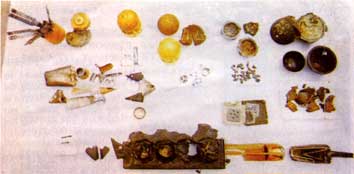 Some kinds of mass killing bombs, among them, the "Frag bomb" was widely used in Vietnam. 各種の大量殺戮爆弾。特に、ボール爆弾はベトナム各地でばら撒かれた。 |
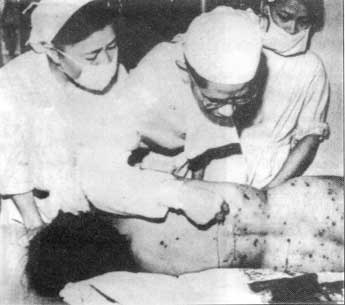 A victim of "Frag " bombs ボール爆弾の犠牲者 |
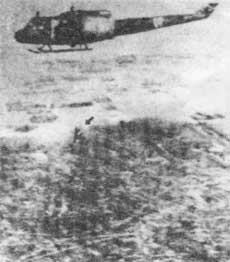 Refusing to answer interrogations, a man was being thrown from a flying helicopter. アメリカ軍の尋問に答えるのを拒否したため、ヘリから落とされたベトナム人 |
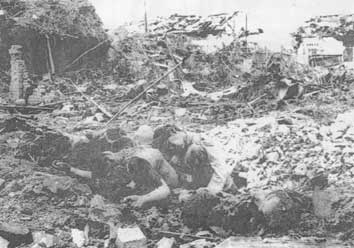 A hospital in the suburbs of Hai Phong city attacked by B.52s during the night of April 16, 1972. 1972年4月16日夜間、ハイフォン市郊外の病院がB52戦闘機によって爆撃を受ける。 |
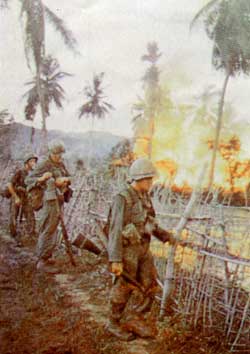 To attack any village, American Infantry troops came to surround it, while jet bombers dropped bombs violently, shooting at random, and finally armed helicopters spat rockets, using machine-guns to fire everywhere. In 1966, Cavalry Division 1, in Binh Dinh. (Bunyo Ishikawa - The war for the liberation of Vietnam) アメリカ軍はある村を襲撃するとき、まず、その村を完全に包囲し、ジェット機を使って激しく爆弾を投下し、無差別銃撃を行った。その後、武装ヘリでロケット弾、機銃弾をあらゆる場所に撃ち込んだ。(1966年第一騎兵師団−ビンディン省)<出典:「ベトナム解放戦争」石川文洋著> |
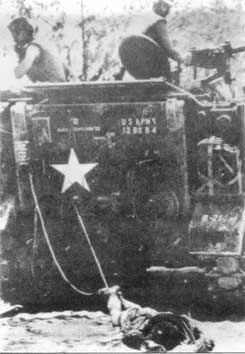 United Press International photographer Kyoichi Sawada top prize for news photography at the 10th annual World Press Photo Exhibition here. This is the photo, called "Dusty Death" that took the prize. It shows the body of a Viet Cong soldier, killed in a night fight with U.S. and Australian Forces, being dragged behind and armored carrier near Tan Binh, South Vietnam. (February 24, 1966) 南ベトナムのタンビン地区で、武装共産ゲリラが米第1騎兵師団部隊の陣地に、猛烈な夜襲をしかけた。夜が明けると米軍の装甲車は、ゲリラ兵の死体を引きずり回した。「泥まみれの死」と呼ばれるこの写真は、沢田教一が撮影し、第10回世界報道写真展ニュース写真部門1位に選ばれた。(1966.2.24) |
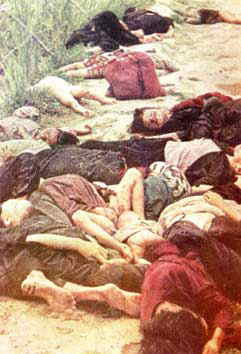 On March 16, 1968 a mass massacre took place in Son My (My Lai) village, Son Tinh district, Quang Ngai province. 504 people were killed. 1968年3月16日、アメリカ兵は、クアンガイ省ソンティン県ソンミ村で虐殺事件を起こし、504人の村人を殺害した。 |
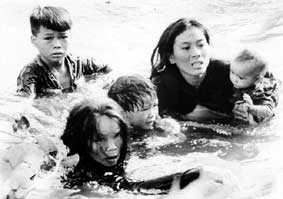 [QUI NHON, South Vietnam] A Vietnamese mother and her children wade across a river to escape U.S aircraft bombs during a strike on their village near here, recently 9/8/1965. The air raid attempted to knock out Viet Cong snipers who were firing on U.S. Marines from the village. Women and Children were removed from the hamlet before the attack began. (Photo by Kyoichi Sawada) 戦場を撮り続けた日本人カメラマン沢田教一を語る上で欠かせない1枚。南ベトナム中部に位置するロクチュアンで、米軍の爆撃で自分たちの村を焼かれ、川をわたって避難する二組の親子の姿が生々しく写っている。米軍は武装共産ゲリラ「南ベトナム解放民族戦線(NLF)」が潜んでいると思われる村々を無差別に空爆し、村の住民は戦火を避けるため流浪を余儀なくされた。1965年2月から米軍の北爆が始まり、ベトナム戦争は本格化していく。(1965.9.8) |
関連リンク